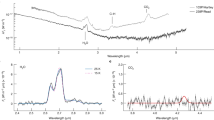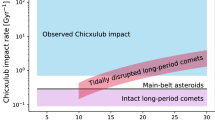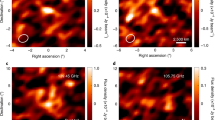Abstract
A COMET nucleus is generally recognised as an icy conglomerate, as was originally proposed by Whipple1. The Orbiting Astronomical Observatory observations of Comet Tago-Sato-Kosaka2 and Comet Bennett3 support the current ideas that H2O is a major component of comets. If comets were indeed formed through an accretion mechanism at distances of many AU from the Sun, what is the nature of the resulting form of water ice?
This is a preview of subscription content, access via your institution
Access options
Subscribe to this journal
Receive 51 print issues and online access
$199.00 per year
only $3.90 per issue
Buy this article
- Purchase on Springer Link
- Instant access to full article PDF
Prices may be subject to local taxes which are calculated during checkout
Similar content being viewed by others
References
Whipple, F. L., Astrophys. J., 111, 375 (1950).
Jenkins, E. B., and Wingert, D. W., Astrophys. J., 174, 697 (1972).
Code, A. D., Houck, T. E., and Lillie, C. F., The Scientific Results from the Orbiting Astronomical Observatory (OAO-2), NASA SP-310, 109 (1972).
Delsemme, A. H., and Wenger, A., Science, 167, 44 (1970).
Ghormley, F. A., J. chem. Phys., 46, 1321 (1966).
McMillan, F. A., and Los, S. C., Nature, 206, 806 (1965).
Delsemme, A. H., and Wenger, A., Planet. Space Sci., 18, 709 (1970).
Whitney, C., Astrophys. J., 122, 190 (1955).
Pittich, E. M., Splitting and Sudden Outbursts of Comets as Indicators of Nongravitational Effects, (Forty-fifth IAU Symposium, Leningrad, 1970), 283 (Reidel, Dordrecht, 1972).
Watson, K., Murray, B. C., and Brown, H., Icarus, 1, 317 (1963).
Sommerfeld, A., Partial Differential Equations, 68 (Academic Press, New York, 1949).
Donn, B., and Urey, H. C., Astrophys. J., 123, 339 (1956).
Author information
Authors and Affiliations
Rights and permissions
About this article
Cite this article
PATASHNICK, H., RUPPRECHT, G. & SCHUERMAN, D. Energy source for comet outbursts. Nature 250, 313–314 (1974). https://doi.org/10.1038/250313a0
Received:
Revised:
Issue Date:
DOI: https://doi.org/10.1038/250313a0
This article is cited by
-
The Electrostatic Blow-Off of Cometary Grains and Variations and Outbursts of Brightness of Comets at Large Heliocentric Distances
Astrophysics and Space Science (2004)
-
Astrophysical implications of amorphous ice—a microporous solid
Nature (1986)
-
The comet Halley dust and gas environment
Space Science Reviews (1986)
Comments
By submitting a comment you agree to abide by our Terms and Community Guidelines. If you find something abusive or that does not comply with our terms or guidelines please flag it as inappropriate.



